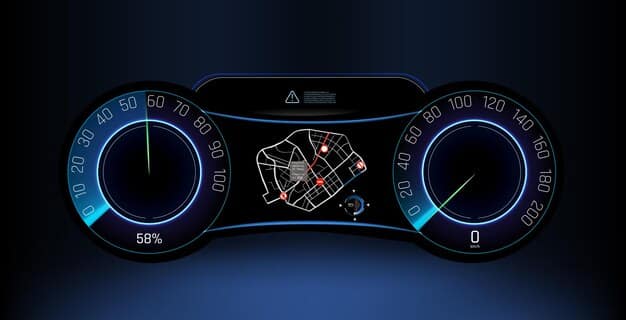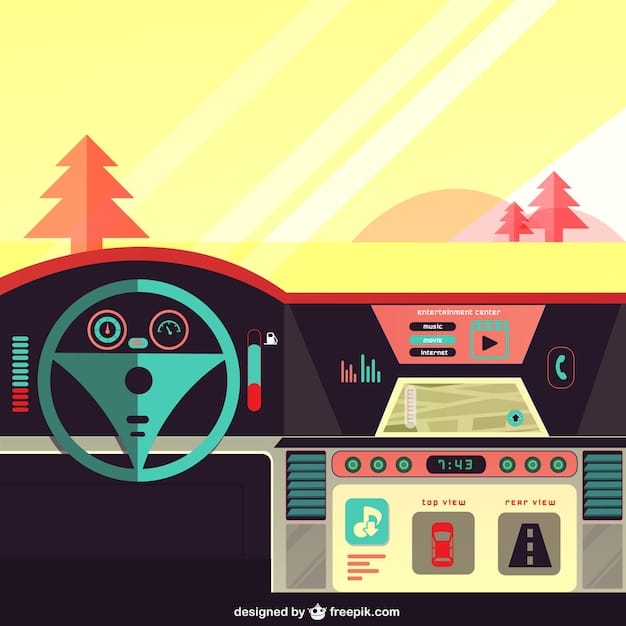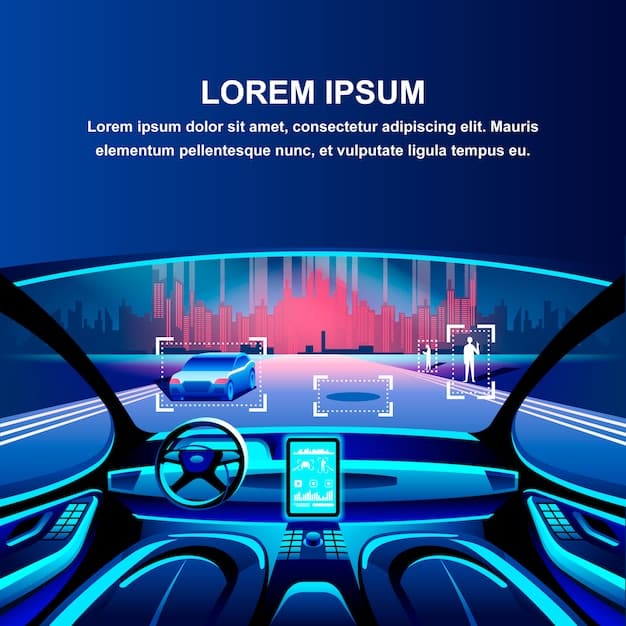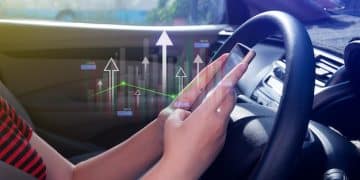The Future of Car Infotainment: Entertainment & Navigation Integrated

The future of car infotainment systems revolves around seamlessly integrating entertainment and navigation through advanced technologies like AI, augmented reality, and over-the-air updates for a personalized and connected driving experience.
The future of car infotainment systems: integrating entertainment and navigation is rapidly evolving. Once limited to basic radio and CD players, these systems are now multifaceted digital hubs, transforming the driving experience.
Exploring the Evolution of Car Infotainment Systems
Car infotainment systems have come a long way. What started as simple entertainment solutions has transformed into complex platforms that manage everything from navigation to vehicle diagnostics.
Understanding this evolution is key to appreciating the innovations shaping the future of these systems.
Early Beginnings: The Radio Era
In the early days, car infotainment was synonymous with the radio. AM radios gave way to FM, offering better sound quality and more stations. Radios became a standard feature, essential for news, music, and entertainment on the road.
- AM/FM Radios: The core of early in-car entertainment.
- Analog Technology: Limited by signal quality and interference.
- Basic Functionality: Primarily for audio entertainment with few additional features.
The Rise of CD Players and Navigation
The introduction of CD players and navigation systems marked a significant leap. CD players offered superior audio quality, while early navigation systems provided turn-by-turn directions, reducing reliance on paper maps.

- CD Players: Improved audio experience in vehicles.
- Early Navigation Systems: Standalone GPS devices offering basic route guidance.
- Limited Integration: These systems often operated independently.
Today’s infotainment systems are a far cry from these early setups. They integrate seamlessly with smartphones, offer advanced navigation, and provide a wide range of entertainment options. The future promises even more sophisticated features.
Advanced Connectivity and Integration
Modern car infotainment systems are all about connectivity. Integrating smartphones, cloud services, and vehicle data creates a seamless user experience. This connectivity enhances functionality, entertainment, and overall convenience.
Connectivity is the bedrock of future infotainment capabilities.
Smartphone Integration: Apple CarPlay and Android Auto
Apple CarPlay and Android Auto have revolutionized in-car connectivity. These platforms mirror smartphone functionality onto the car’s display, allowing drivers to access navigation, music, and communication apps safely.
Seamless integration ensures drivers can stay connected without sacrificing safety.
Cloud Services: Streaming and Over-the-Air Updates
Cloud services bring a wealth of entertainment options to the car. Streaming music, podcasts, and audiobooks are now commonplace. Over-the-air (OTA) updates keep the system and vehicle software current with the latest features and security patches.
OTA updates are crucial for maintaining system performance and security.
Vehicle Data Integration
Modern infotainment systems can also access and display vehicle data. Information like fuel consumption, tire pressure, and engine diagnostics can be presented in an easy-to-understand format. This integration helps drivers stay informed about their vehicle’s performance.
- Real-time Vehicle Data: Access to critical vehicle information.
- Performance Monitoring: Ability to track fuel efficiency and tire pressure.
- Predictive Maintenance: Systems that can alert drivers to potential issues.
Advanced connectivity is transforming the driving experience. Drivers now expect seamless integration, access to cloud services, and real-time vehicle data. These capabilities are becoming standard in modern cars.
Artificial Intelligence (AI) in Infotainment Systems
AI is set to play a significant role in the future of car infotainment. From voice assistants to predictive navigation, AI is enhancing personalization, safety, and convenience.
The integration of AI promises a more intuitive and responsive infotainment experience.
Voice Assistants: Natural Language Control
Voice assistants like Siri, Google Assistant, and Alexa are becoming increasingly common in cars. These assistants allow drivers to control various infotainment functions using natural language, reducing distraction and enhancing safety.
Voice control is revolutionizing how drivers interact with their vehicles.
Personalized User Experience
AI can analyze driver behavior and preferences to create a personalized user experience. The system can learn frequently visited locations, preferred music genres, and optimal climate settings, adjusting automatically to suit the driver’s needs.
Personalization through AI enhances comfort and convenience.

Predictive Navigation and Route Optimization
AI-powered navigation systems can predict traffic patterns and suggest optimal routes based on real-time conditions. The system can also learn the driver’s typical commute and proactively offer alternative routes to avoid delays.
- Real-time Traffic Analysis: AI algorithms that analyze traffic data.
- Route Optimization: Predictive routing to avoid congestion.
- Proactive Suggestions: Automated route suggestions based on driver habits.
AI is poised to transform car infotainment systems. As AI technology advances, drivers can expect even more intuitive, personalized, and safe driving experiences.
Augmented Reality (AR) and Enhanced Displays
Augmented reality (AR) is set to revolutionize how drivers perceive information. AR displays can overlay digital information onto the real world, enhancing navigation, safety, and situational awareness.
AR technology promises to make driving safer and more intuitive.
Head-Up Displays (HUDs) with AR
Head-up displays (HUDs) are becoming more common in modern cars. AR-enhanced HUDs can project navigation directions, speed limits, and safety alerts directly onto the windshield, in the driver’s line of sight. This reduces the need to look away from the road.
- Enhanced Situational Awareness: Digital information overlaid on the real world.
- Reduced Distraction: Key information displayed in the driver’s line of sight.
- Improved Safety: Real-time alerts and warnings.
AR Navigation: Overlaying Directions on the Road
AR navigation systems can overlay turn-by-turn directions onto the video feed of the road ahead. This makes it easier for drivers to follow navigation instructions, especially in complex intersections. The visual cues provided by AR navigation can significantly reduce the risk of missed turns or wrong exits.
AR navigation offers a more intuitive and safer way to follow directions.
Advanced Display Technologies
Beyond AR, advanced display technologies like OLED and curved screens are enhancing the visual experience in car infotainment systems. These displays offer brighter colors, higher contrast ratios, and wider viewing angles, making information easier to read and more visually appealing.
Next-generation displays enhance the overall infotainment experience.
Augmented reality and advanced display technologies are transforming the way drivers interact with their vehicles. By providing information in a more intuitive and engaging way, these technologies are enhancing safety and convenience.
The Impact of 5G and Faster Networks
The rollout of 5G networks is set to have a profound impact on car infotainment systems. Faster speeds, lower latency, and increased bandwidth will enable new features and enhanced performance.
5G connectivity is a game-changer for in-car technology.
Enhanced Streaming Capabilities
With 5G, streaming music, videos, and games in the car will become seamless. High-definition video streaming and online gaming will be possible without buffering or interruptions. This will enhance the entertainment options available to passengers.
5G will unlock new possibilities for in-car entertainment.
Real-Time Data and Enhanced Navigation
5G will enable real-time data processing, allowing for more accurate and responsive navigation systems. Traffic updates, weather alerts, and road condition information can be delivered instantly, helping drivers make informed decisions and avoid potential hazards.
- Instant Traffic Updates: Real-time traffic information for route optimization.
- Enhanced Weather Alerts: Timely warnings about adverse weather conditions.
- Improved Route Planning: Dynamic rerouting based on current conditions.
OTA Updates and Software Enhancements
5G will facilitate faster and more reliable over-the-air (OTA) updates. Large software updates and new features can be downloaded and installed quickly, ensuring that the infotainment system and vehicle software are always up to date.
Faster OTA updates will keep vehicles current and secure.
The advent of 5G is poised to revolutionize car infotainment systems. With faster speeds, lower latency, and increased bandwidth, 5G will enable new features, enhanced performance, and a more connected driving experience.
Cybersecurity and Data Privacy Considerations
As car infotainment systems become more connected and integrated, cybersecurity and data privacy are becoming critical concerns. Protecting sensitive information and preventing cyberattacks are essential for ensuring the safety and security of connected vehicles.
Cybersecurity is paramount in the age of connected cars.
Protecting Sensitive Data
Car infotainment systems collect and store a wealth of personal data, including location history, contact lists, and payment information. Protecting this data from unauthorized access is crucial. Carmakers are implementing encryption, firewalls, and intrusion detection systems to safeguard sensitive information.
- Data Encryption: Protecting data through encryption techniques.
- Firewalls: Preventing unauthorized access to the system.
- Intrusion Detection: Monitoring for and responding to potential cyberattacks.
Preventing Cyberattacks
Connected car systems are vulnerable to cyberattacks, which can compromise vehicle safety and security. Carmakers are working with cybersecurity experts to identify and address potential vulnerabilities. Regular software updates and security patches are essential for mitigating cyber risks.
Cybersecurity is an ongoing effort to protect connected vehicles.
User Awareness and Best Practices
Drivers also have a role to play in safeguarding their data and protecting their vehicles from cyberattacks. Being aware of potential risks and following best practices can significantly reduce the likelihood of a security breach. This includes using strong passwords, avoiding suspicious links, and keeping software up to date.
User awareness is a key element of cybersecurity.
Cybersecurity and data privacy are critical considerations in the future of car infotainment systems. By implementing robust security measures and promoting user awareness, carmakers can ensure the safety and security of connected vehicles.
| Key Aspects | Brief Description |
|---|---|
| 🚗 Integration | Seamless integration of smartphones and cloud services. |
| 🤖 AI | AI-powered voice assistants and personalized user experiences. |
| 🌐 5G | Faster speeds and lower latency for enhanced streaming and data. |
| 🛡️ Cybersecurity | Protecting sensitive data and preventing cyberattacks in connected vehicles. |
Frequently Asked Questions
▼
Integrating smartphones enables access to navigation, music, and communication apps safely. It mirrors smartphone functionality on the car’s display, enhancing user experience and convenience while driving.
▼
AI personalizes the user experience, offers predictive navigation, and provides voice control for various functions. It learns driver behavior and preferences, adjusting system settings to suit individual needs, enhancing comfort and safety.
▼
AR overlays digital information onto the real world, enhancing navigation and situational awareness. AR-enhanced head-up displays (HUDs) project directions and alerts onto the windshield, reducing distraction and improving safety for drivers.
▼
5G enhances streaming capabilities, enabling seamless music and video streaming. It allows for real-time data processing, providing accurate navigation and traffic updates. Additionally, it facilitates faster over-the-air (OTA) software updates, keeping systems current.
▼
Essential measures include data encryption, firewalls, intrusion detection systems, and regular software updates. These protect sensitive data from unauthorized access and prevent cyberattacks, ensuring the safety and security of connected vehicles.
Conclusion
The evolution of car infotainment systems is rapidly advancing, driven by technological innovations like AI, AR, and 5G. As these systems become more connected and integrated, they offer enhanced entertainment, navigation, and safety features, transforming the driving experience for both drivers and passengers. The future holds even more exciting possibilities as connectivity and technology continue to advance.





